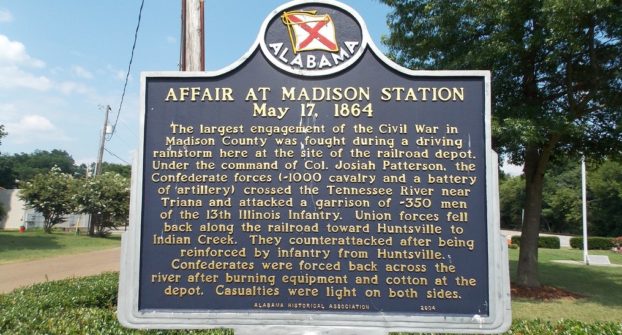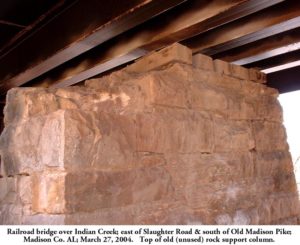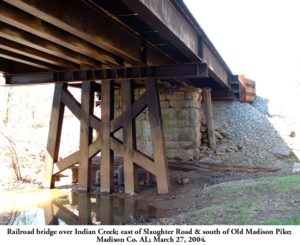
- A historical marker now stands in downtown Madison mark the small engagement between Union and Confederate troops in May 1864. Courtesy of JOHN RANKIN
Sunday marks the 156th anniversary of “affair” at Madison Station
By John P. Rankin, Madison historian
MADISON – There were only two battles of any size fought in Madison County during the Civil War. They were both fought in and around the town of Madison, about seven months apart. Madison’s location along the railroad halfway between Huntsville and Decatur was one of the primary reasons for its strategic importance at the time. The outcomes of both local Civil War engagements were affected by weather extremes.
Artillery and rifles were the weapons of the day for the conflict that occurred on May 17, 1864, in a driving rain that obscured vision and minimized likelihood of audible detection of forces approaching for the surprise attack. The engagement began shortly after dawn with Confederate fire upon the occupying Union forces around the railroad depot in Madison.
The Confederate attack began after the Southern troops had crossed the river at Triana during the night, taken out the Union sentries, and surrounded the town on all sides. The Rebels also had brought along four small cannons or howitzers, but some reports indicate that one of the big guns was not usable.
The alarm was reportedly first sounded for the Union troops in the town when one of their foraging parties encountered Confederates north of the historic district around 8 a.m. However, the town was already surrounded, so the Union troops fought from behind bales of cotton piled around the train depot and from a small barricaded “fortress” in one of shops on the south side of Main Street.
After receiving incoming cannon fire at the depot loading dock, the Union commander realized that their position was untenable, so they focused a counterattack along the railroad to break out toward Huntsville, where the main Union forces were quartered. The engagement continued eastward along the tracks to the Indian Creek railroad bridge. The stone support columns are still in place just beyond the southeastern corner of today’s Madison Academy campus.
The modern rails do not actually rest upon the old stone columns now. It was at the eastern end of this bridge that the Union troops regrouped and held their position across the creek until later in the day when reinforcements arrived by train from Huntsville. Meanwhile, before retreating the Rebel force set fire to the depot and to the cotton bales that the Union had confiscated.
By the time the Union counterattack from the railroad bridge at Indian Creek commenced, the Rebel troops had looted the tents, armaments, and other supplies that the escaping Union forces had hastily abandoned in the town. Before the end of the day, the Confederates had gone back across the river at Triana with some captives and their plunder. A Confederate history report written in 1890 at one point stated that 80 Union prisoners were taken. In another place the number was given as 130 prisoners, while stating that the Federal Garrison numbered 400 men. Patterson was stated as losing only 7 killed and wounded.
The many accounts of the “affair” include numerous variations of the details, as written by defensive Union commanders and later by sparse Confederate memories. However, all agree that it was raining so hard that the combatants could barely see their opposition.
The Union accounts described the event as involving far more rebels than could possibly have been present at that point in the war here. The local Southern defense forces were ill-equipped, exhausted, and low on munitions in 1864. The information which follows is excerpted from a book of 123 pages written by Lloyd Lanphere (deceased), as published in 2001 by the Madison Station Historical Preservation Society.
The official Union reports claimed that 350 Union troops of the 13th Illinois Infantry were attacked by a Rebel force of between 1,000 and 1,500 cavalry and infantry. More realistic descriptions suggest that a maximum of 500 under-fed and worn-out but desperate Confederates were raiding for supplies when they routed the well-rested Union troops from leisurely sleep as they were awaiting muster out of service within a few weeks.
An 1866 history of the 13th Illinois Infantry stated that 66 Union pickets and skirmishers were captured by the Rebels, who suffered 60 killed, wounded, or missing.
Written Confederate reports are sparse from the last months of the war, but there are numerous descriptions of the engagement preserved in official Union accounts. The most descriptive Union reports were filed by a defensive Colonel Adam Gorgas of the 13th Illinois Infantry.
He first reported on the day of the engagement that “We were attacked this morning at 8 o’clock by a cavalry force under Patterson, numbering about 1,000, with four pieces of artillery.” Considering their rude and sudden awakening and the driving rain, one can wonder how well the opposition could be numbered by the Union force as it fled for safety toward Huntsville.
When Brigadier-General C. L. Matthies communicated on the 17th to Lt. Col. R. M. Sawyer about the event, he stated that “Rebel Patterson crossed with 500 men, three pieces of artillery, near Triana, moved on to Madison Station, destroyed all but the railroad, took Colonel Gorgas prisoner and 50 men, fell back to the river, not known if he crossed.”
When Gen. Matthies reported to General J. E. Smith about the engagement later that day, he stated that a “Telegram from Decatur Junction says 2,000 mounted rebels at Madison Station. Burnt the town.”
It should be kept in mind that avoidance of disgrace and eligibility for promotions depended upon an ability to write reports containing good rationale for actions and outcomes. Sometimes details were a bit exaggerated.
Gorgas in his initial report further recounted that “…We were obliged to fall back, after a severe fight, and, being completely surrounded, we cut our way through their lines, and fell back to the bridge and water tank, about three miles east. We formed and returned to this place (Madison), and, after skirmishing, drove them from the town. They captured several of our men, what number we are not able to say. Our camp and garrison equipage, together with all the regimental and company papers, are either destroyed or carried off. The depot buildings are burned, together with about 50 bales of cotton. (He said 70 bales in a report two days later.) The railroad is all right, telegraph lines cut. We are left here without rations, and but little ammunition.”
Col. Gorgas did not mention in his initial report that the counterattack did not occur until his force was greatly augmented by a trainload of Union troops and cavalry from Huntsville. Nor did he describe the true helter-skelter run along the tracks to escape from the town, as his unprepared force was lightly dressed and poorly armed while they were lost from sight in the downpour of rain and protected by the dense forest on each side of the tracks. He also forgot to say that the Rebel force had already retired from the town with wagonloads of plunder before he and his reinforcements returned to the town.
A much more detailed account of the engagement was filed by Col. Gorgas on the 19th of May, as follows: “I would respectfully submit the following report of the attack made on this post (Madison Station) by a force of the enemy, under command of Colonel Patterson, consisting of two regiments of mounted infantry and a battery of four 12-pounder howitzers, the entire force numbering about 1,000 men.
The attack was made at 8:30 a.m. on the Triana road, on which two of their field pieces were placed in position, the two remaining pieces having crossed the railroad, together with a portion of the enemy’s command. They, however, did not get into position, as the attack was precipitated by the enemy’s being discovered by a forage train, which was just starting out.
As soon as discovered the enemy opened fire from their two pieces on the Triana road, having previously sent detachments to each one of my picket posts, five in number, guided by some citizens who seemed to know the exact locality of each, encircling them and capturing them entire. On the first alarm my command was quickly formed in line, excepting three companies, who occupied the stockade in the rear of the depot.building behind some cotton bales. Two companies were thrown out as skirmishers, but the enemy appearing in such a large force in their front, I ordered them to fall back to the main column.
In the meantime the stockade was rendered untenable by the rapid fire from the artillery, so that the three companies were compelled to fall back behind the railroad embankment, where I at length formed my entire command, being satisfied that we were outnumbered nearly four to one, and having nothing to resist their artillery, it would be impossible to hold the town, my command the entire time keeping up a rapid and incessant fire, killing 3 and wounding 15 of the enemy.
At this time the rebel force appeared on both flanks and in my rear, which made it necessary to fall back still further, which I did, in the direction of the water tank toward Huntsville, dispersing the enemy in my rear by a few well-directed volleys, the artillery and nearly their entire force following on either side of the railroad, but the timber was so thick that they could do no damage.
On arriving at within a half mile of the water tank I reformed my line, and after a short rest, again advanced toward Madison Station with a strong line of skirmishers, well extended on either side of the railroad. The skirmishers drove the rear guard of the enemy from town, the main force having departed after burning the depot buildings and about 70 bales of cotton. My camp equipage was also burned, it, however, consisting of only a small number of tents, which were scarcely serviceable. The men, also, have lost all their extra clothing and blankets. The damage to the railroad was slight and readily repaired.
As soon as the attack was made the wagon train, consisting of eight 6-mule teams and three 2-horse ambulances, were ordered on the Huntsville road, but were intercepted and captured, together with a small train guard and the teamsters.
About 12 noon re-enforcements arrived, consisting of the Fifth Ohio Cavalry, Colonel Heath, 120 men, and the Fifty-ninth Indiana Infantry, Lieutenant-Colonel Scott, 220 men. These, together with 100 men from my regiment, moved after the enemy as rapidly as possible in a driving rain. Colonel Heath’s cavalry came up with the rear guard of the enemy early in the afternoon, and kept up a constant harassing fire, but his force was too small to make a forcible attack.
The infantry came up just before sundown, the Fifty-ninth Indiana deploying as skirmishers and driving the enemy before them to the bank of the river, but night coming on and finding that the transportation (wagons) and prisoners were all across the river, our men fatigued, and ammunition almost exhausted, it was considered by the commanding officers to withdraw our forces. They were consequently marched back to Madison, a distance of 12 miles from Fletcher’s Ferry.
From reliable sources I learned that the enemy’s loss at the ferry was 15 killed and 40 wounded. This estimate, I am positive, is not placed too high, which would make their entire loss 18 killed and 55 wounded. Of the number of prisoners from my regiment I have not been able to learn how many were wounded. The loss of the Fifty-ninth is 2 wounded, and the Fifth Iowa Infantry 1 killed. I have but 1 man wounded with the regiment. …”
In a lengthy report by Brig. Gen. John E. Smith dated May 18, he stated several discrepancies from the Gorgas reports. The Smith report told of an estimated force of up to 3,000 Rebel forces, and that the first warning of the attack was receiving fire into the Union camp.
The first report into Huntsville said that the Madison Station occupying Union force would no doubt be captured. Smith stated that his first action was then to order out the Fifth Ohio Cavalry and the Eighteenth Wisconsin Infantry. He also directed that a regiment be sent by train from Larkinsville in Jackson County. He further said that while awaiting the regiment he proceeded to arm all detachments, convalescent soldiers, teamsters, etc., in order that every man could be available (to defend Huntsville, expecting an attack there).
Then he started the Fifty-ninth Indiana Infantry toward Madison after placing cotton bales and ammunition in position. Later in the afternoon he sent the Forty-eighth Indiana to Madison. When the Union troops encountered the Confederate rear guard near Triana, Smith reported that they killled 1 man, wounded several, and captured 4 prisoners and some 30 or 40 horses. He concluded his report with the statement that after receiving the initial Gorgas report, he was led to believe that Gorgas was “culpably negligent.”
Col. Gorgas blamed the successful surprise at Madison Station upon local citizens guiding the rebels to the locations of his five pickets, who were then overwhelmed before they could sound the alarm. In fact, subsequently the Union occupiers arrested Madison residents Dr. Richard Matthew Fletcher, Edward Betts, and James Harvey Pride. They were taken into Huntsville to be tried and hanged as spies for complicity in the event.
After a gallows was constructed, a recently-transferred and remotely-billeted but friendly senior Union officer who knew that Dr. Fletcher had compassionately treated Federal soldiers during the occupation years came to Huntsville and had the men released.
One can also contrast the Union conditions with those reported by the Confederate commander in the attack, Col. Josiah Patterson. When he wrote to his commander, General Phillip Dale Roddey, on June 27 of 1864, just six weeks after the “affair” at Madison Station, he recounted his many engagements and marches during the recent months.
He stated that he had 250 men in the Fifth Alabama Cavalry at that time. He mentioned having been in engagements at not only Madison Station but also Fletcher’s Ferry, Garth’s Farm, and Moulton. His men had been sent to Aberdeen (Mississippi), then to Gadsden, from there to Rome and Dalton (Georgia), then back to Decatur (Alabama), Talladega, , Moulton, Tupelo (Mississippi), Big Bear Creek (Alabama), Decatur, Corinth (Mississippi), and back to Pond Spring (Alabama). Much of the time was spent on quarter rations of corn in traversing mountains.
Patterson wrote that his men had marched, under orders, over 1,200 miles in the last five months without firing a shot in addition to the many engagements and skirmishes along the way. He told Gen. Roddey that “You can well imagine, after all this marching, the condition of these men. I have sacrificed my command, ruined the horses of my brigade, in marching and counter-marching in obedience to orders, and for my life I cannot see where I have benefited the country in a single instance during all these marches. Horses have broken down by the way in large numbers, thus reducing the efficiency of my command at almost every step. You are aware that all of this has been done on less than half rations of corn.
The troops that I move with in the morning, although once finely mounted, are now in very bad condition, and half the horses, so I am informed by the captains, are not able to march twenty-five miles without lagging and giving out…. If my brigade was inspected today there would not be 200 horses found fit for active service….”
This does not seem to fit as a description of the “overwhelming” Confederate force that routed the Union occupiers at Madison Station so efficiently, but it was an actual report written in confidence by Col. Patterson to his commanding general — not for excuses.





